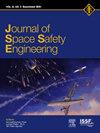局部热固化增强多层充气结构空间碎片屏蔽性能
IF 1.7
Q3 ENGINEERING, AEROSPACE
引用次数: 0
摘要
本研究提出了一种部分热固化的空间碎片防护罩,其中只有一些传统的多冲击织物防护罩片被热固化。这种方法简化了在轨热固化,因为与完全热固化的充气结构相比,需要固化的材料更少。超高速实验检测了碎片防护层内固化层的最佳放置位置,结果表明,将固化层放置在第一层的上游,可以最大限度地提高防护性能。本研究评估了相同面密度条件下充气式结构对空间碎片碰撞的防护性能,强调了热固化对多重冲击防护性能的改善。超高速撞击实验表明,部分热固化的护盾穿透面积明显小于未固化的护盾,证实了热固化的好处。我们建立了局部热固化屏蔽应用的扩展角和弹道极限方程。这些方程验证了在部分固化的情况下,即使减少了对峙,也能保持有效的碎片保护。采用光滑颗粒流体力学的数值模拟证实了实验结果,表明策略性放置的热固化层增强了保护作用。总的来说,这些发现表明,部分热固化护罩提高了空间充气结构的保护和部署效率。本文章由计算机程序翻译,如有差异,请以英文原文为准。
Partial heat curing enhancing space debris shielding performance in multi-layered inflatable structures
This study proposes a partially heat-cured space debris shield, where only some sheets of traditional multi-shock fabric shields are heat-cured. This approach simplifies on-orbit heat curing as it requires curing a smaller portion of material compared to fully heat-cured inflatable structures. Hypervelocity experiments examined the optimal placement of cured layers within the debris shield, showing that placing them on the upstream side of the first layer maximizes protection performance. This study assessed the protective performance of inflatable structures against space debris collision under consistent areal density conditions, highlighting the improved performance of multi-shock shields subjected to heat curing. Hypervelocity impact experiments revealed that the penetration area of partially heat-cured shields was significantly smaller than that of uncured shields, confirming the benefits of heat curing. We developed spread angle and ballistic limit equations for partial heat-cured shield applications. These equations verified that effective debris protection can be maintained with partial curing, even with reduced standoff. Numerical simulations using smoothed particle hydrodynamics corroborated the experimental results, indicating that strategically placed heat-cured layers enhance protection. Overall, these findings suggest that partially heat-cured shields improve the protection and deployment efficiency of inflatable structures in space.
求助全文
通过发布文献求助,成功后即可免费获取论文全文。
去求助
来源期刊

Journal of Space Safety Engineering
Engineering-Safety, Risk, Reliability and Quality
CiteScore
2.50
自引率
0.00%
发文量
80
 求助内容:
求助内容: 应助结果提醒方式:
应助结果提醒方式:


